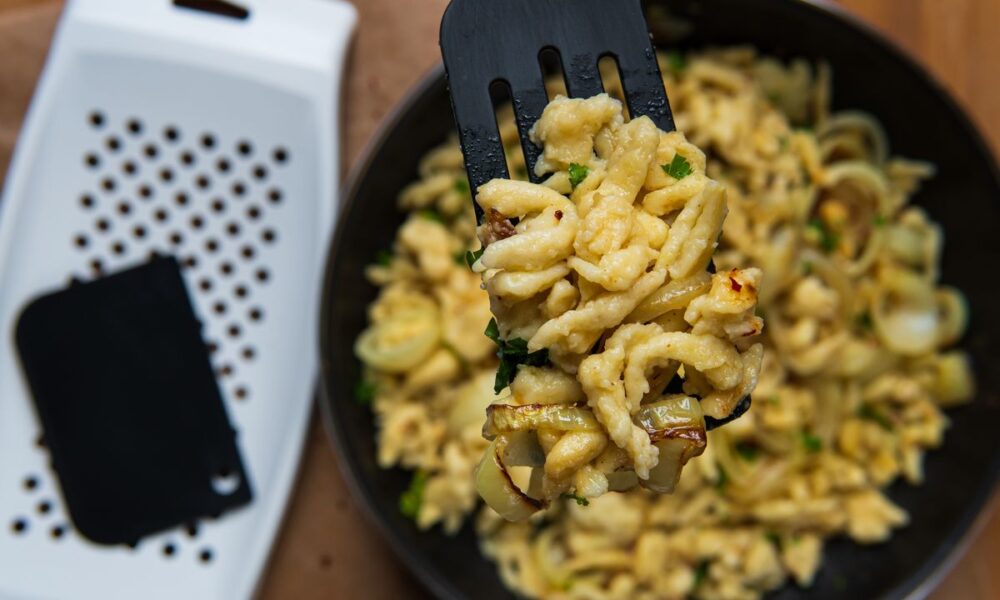Recipes
Spätzle, the original recipe

Originally from Germany, spätzle is a typical dish of South Tyrol. Here's how to prepare them with the original recipe.
Spätzle are a typical recipe from southern Germany, but are also eaten very often in Alto Adige, Trentino and Switzerland. Their name , spätzle, literally means sparrows, and there are different ways of preparing them: they can in fact be passed through a special tool, cut by hand using a special board or with a knife or spoon.
As for the seasoning of spätzle, meat sauces, or cream cheeses or simply melted and flavored butter or cooking cream are usually preferred. They are often then served as a side dish for meat stews and not as a first course as we usually do.
How to prepare the spätzle recipe
- To prepare your spätzle, pour the 00 flour into a bowl. Break the eggs in the center and beat them with a fork. Add a pinch of salt and then mix by adding water at room temperature. Flavor with nutmeg (not too much).
- Mix the mixture well with a hand whisk, to form a homogeneous batter that is thick but not too thick. If dropped into water it will form drops.
- When the consistency seems right, bring a pan of salted water to the boil and begin dropping drops of batter through the spätzle tool. Alternatively you can use a potato masher with large holes but there are also tablets, from which you can make perfect spätzle with the help of a spatula. Drain them as soon as they come to the surface.
- Melt the butter in a pan and transfer the spätzle directly using a slotted spoon. Distribute on plates and complete with chives and grated parmesan .
Here is a video showing how the utensil works and the consistency of the batter. You will thus be able to get an idea of how to proceed even following alternative routes.
The most widespread version in Italy, however, is the spinach version. With their particular color and unique flavor they are perfect if you are looking for a simple but different first course from the usual. The idea of preparing both (halving the doses) is also excellent so as to obtain a two-coloured dish.
Variants
Depending on the tool used to prepare them, spätzle take different shapes:
- knöpfle : drop shape obtained with the spätzlehobel , a grater with holes on which a container slides into which the batter is placed;
- cut by hand : the spätzlebrett is used, a wooden cutting board on which the batter is spread and then dropped into the water with the help of a knife. The shape in this case is more elongated, similar to fettuccine;
- Pressed spätzle : Made with a potato masher-like tool called a spätzlepresse .
In Germany, they are seasoned in several ways: käsespätzle , covered in cheese, baked au gratin with Emmental and garnished with fried onion fillets; linsen, spätzle und saitenwürstle , white and served with frankfurters and stewed lentils; krautspätzle flavored with herbs and cooked in a sauté of butter and onions; leberspätzle , with liver; and finally in a sweet version served with cherries or apples, sugar and cinnamon, the Kirschspätzle and Apfelspätzle .
Conservation
This delicious dish (in both versions) should be eaten at the moment , as soon as it is ready and nice and hot. You can also store them for up to a day in the refrigerator and reheat them if necessary before serving them. We do not recommend freezing in the freezer.
Origin and history
Spätzle is a dish born in medieval times . Typical specialty of Swabian cuisine, they spread first in Germany and Austria, then in Italy, especially in Alto Adige. Their name, as mentioned, means little sparrow but it is not clear whether it can be attributed to their particular shape or to the fact that they were usually served as a side dish to game dishes .
In Germany, the place of birth, the most popular spätzle are the white ones and, traditionally, they are served as a side dish. In Italy they are instead a first course and the most common variant is the green one ( spinatspätzle ), with spinach or herbs in the batter. The rustic version with buckwheat flour in the dough is also very popular.
Riproduzione riservata © - WT